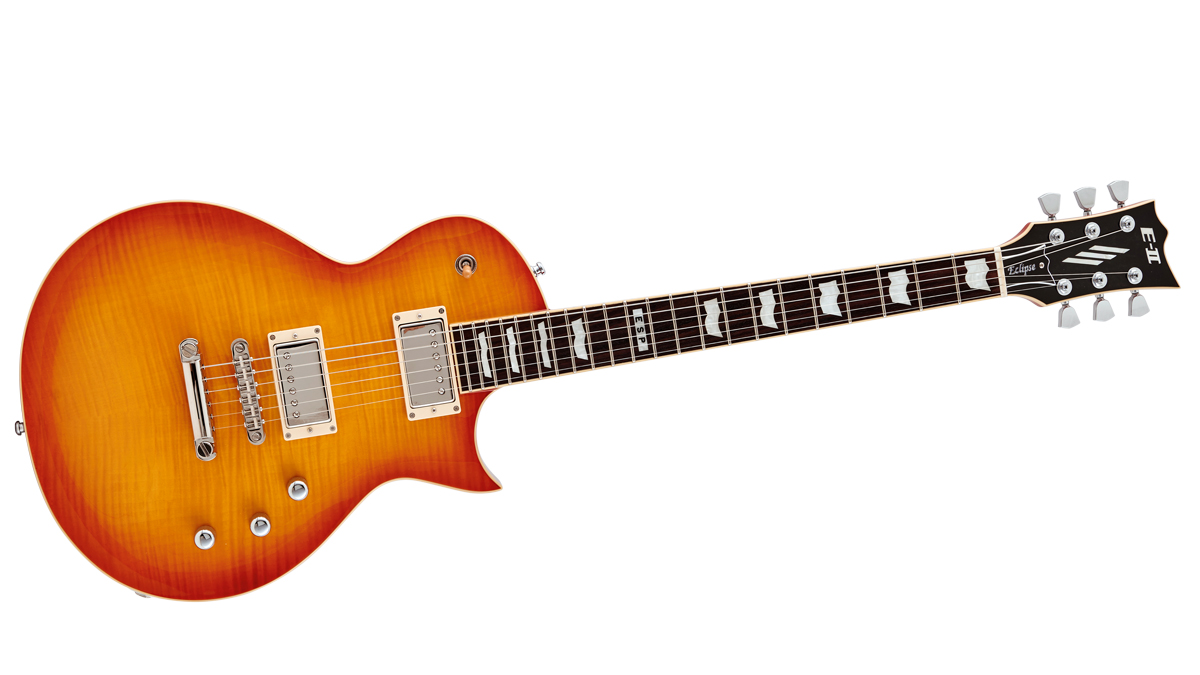MusicRadar Verdict
In terms of fit and finish the Eclipse is as good as anything you’ll find for around £2,000.
Pros
- +
Awesome build quality combined with excellent playability and an iconic set of Seymours to produce a widespread appeal.
Cons
- -
The super slim neck might not make everyone’s day.
MusicRadar's got your back
Designed to “bridge the gap between ESP’s premium and more affordable LTD models,” the relatively new E-II range features high-spec Tokyo-built renderings of the Japanese brand’s rock and metal- flavoured favourites.
You shouldn’t need Lieutenant Columbo to help you figure out what guitar the model we have today takes inspiration from. The shadow cast by the single-cutaway body is a big clue. Figure in a mahogany back mated to a contoured maple top and you’re in classic Les Paul territory. Ditto, the anchored tune-o-matic bridge and stop tailpiece (both sourced via Gotoh) and the twin humbucker format.
The trail only begins to go cold when we turn the guitar over. The Eclipse body is thinner than that of the 50s icon, which is reflected in its weight of just under eight pounds - a non-weight relieved Les Paul is usually 10 pounds or more.
It’s like ESP hot-rodded a Les Paul by stripping it of some body weight, re-profiling the cutaway, and dumping stuff like the pickguard and one of the tone controls. That hot-rod vibe is enhanced by the cool racing flag fingerboard inlays, matching truss rod cover and headstock profile.

The Eclipse features a thin one-piece mahogany neck with a 305mm (12") fingerboard radius and 22 beautifully seated and crowned extra jumbo frets. The neck comes with locking Gotoh tuners with metal tulip buttons, a perfectly cut bone nut, and a volute at the point where the headstock begins to add some strength. Additional security is provided by a set of Schaller strap-locks and a tough oblong case with a fitted interior and accessories pocket.
The Eclipse we have here features a Vintage Honey Burst finish flame maple top, rosewood fingerboard and chrome hardware. It also has a single-bound body with a sculpted thru-neck construction. This means there’s no neck heel to get in the way when you venture up to fat fret number 22. There’s more creative woodwork in the form of a belly cut for added comfort, and a couple of control cavities for access to the wiring.
The Eclipse conducts its business via the iconic Seymour Duncan humbucker pairing of a bridge-mounted SH-4 JB ‘Jazz Blues’ - best known by everyone as the ‘Jeff Beck’ - and its faithful companion, the SH-1 ’59, in the front position.
Want all the hottest music and gear news, reviews, deals, features and more, direct to your inbox? Sign up here.
Sounds
Straight from the case, the action on this guitar is so low a hapless microbe wandering across these fingerboards might bump its head on the bottom of the strings. This state of affairs is perfect for legato-lusting shredders with a light touch.
If, on the other hand, you like to thump your strings to jelly you’ll likely have to raise the action a bit to bump off any unwanted buzzes and rattles.
Most of us have tried the Seymour JB/’59 setup, haven’t we? The JB sparkles on a clean setting but really comes into its own with some old school overdrive. It’s a cracking classic rock meets blues pickup and produces enough power without compromising tone and warmth.
The action on this guitar is so low a hapless microbe wandering across these fingerboards might bump its head on the bottom of the strings
The ’59 is everything its name suggests. Smooth and woody, it works well for clean blues or jazz. We like the way it warms up when you take the tone control down a couple of notches. Adding some grit dials in a flutey sounding sustain that favours laconic blues noodling.
ESP has long been typecast as a go-to make for metalheads and shredders, a situation happily perpetuated by the brand itself. So where does that leave the rest of guitar playing humanity who might otherwise dismiss ESP’s wares while looking for a new six-string squeeze?
Well, as its lines are informed by an all-time classic, the Eclipse is the least overtly ‘metal’ looking thing in the ESP catalogue. Sure, there’s a touch more aggression in the sharpened cutaway, and some Kustom Kulture vibe-age in the racing flag fingerboard inlays and headstock.
Yet, even if the EMGs alienate some, we can see this beautiful guitar looking the part in a classic rock, blues rock or even jazz setting. And since when was a wish list that includes an ultra comfortable neck shape, excellent upper fret access and a super low action solely the preserve of the metal fraternity?
If you’re on the sniff for a single-cutaway, mahogany/maple, twin-humbucker-loaded tone machine, you might just find the ESPs ‘eclipse’ the charms of the competition from the likes of Gibson and PRS. In terms of fit and finish the Eclipse is as good as anything you’ll find for around £2,000.
